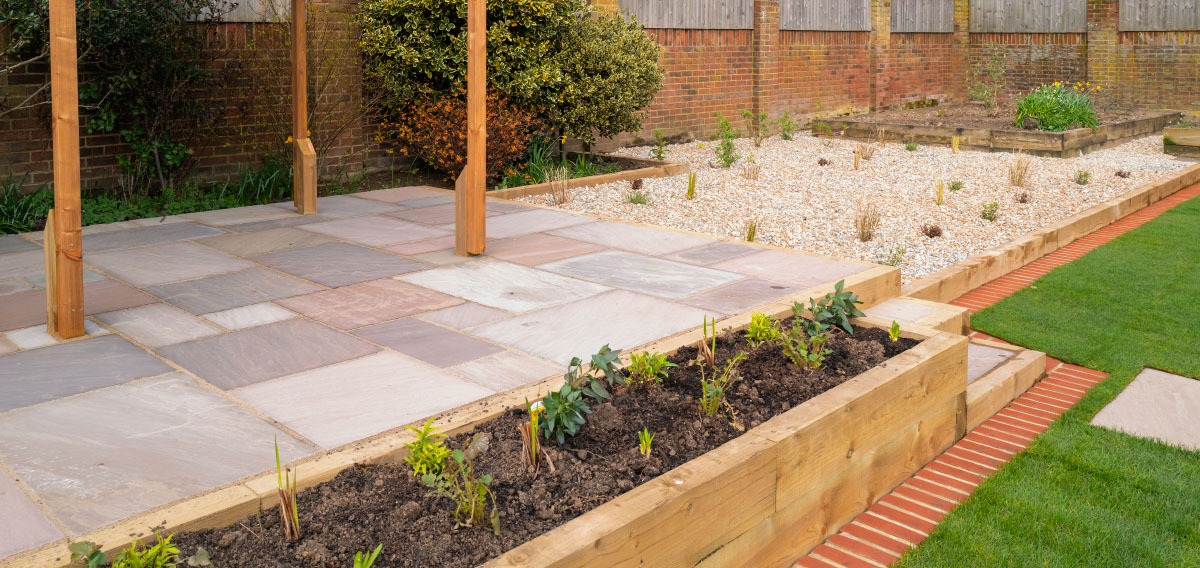Railway sleepers are a popular alternative to hard landscaping materials such as stone, brick or concrete, and offer near-endless possibilities to the keen DIYer looking to transform their outdoor space.
Functional and cost-effective, treated softwood or hardwood timber sleepers are extremely durable and will last many years if installed following best practices.
Garden sleepers are also aesthetically versatile, suited to use in both traditional and contemporary settings. The waney edges and aged finish typical of reclaimed sleepers offer rustic charm, while the clean edges of new sleepers provide a sharp, modern-looking aesthetic.
Ways you can use garden sleepers
1. Garden edging
Sleepers are a stylish way to transition from lawn or patio to flowerbed, and will help prevent grass and weeds from spreading.
Wooden edging with a tall enough profile will also ensure that any topping material – such as bark or gravel – will stay put, and should allow water to drain freely, preventing borders from becoming heavily saturated.
Single height edging should do the job in most cases, which means you can simply dig a shallow trench, prepare the ground using sand or aggregate, then lay your sleepers on top.
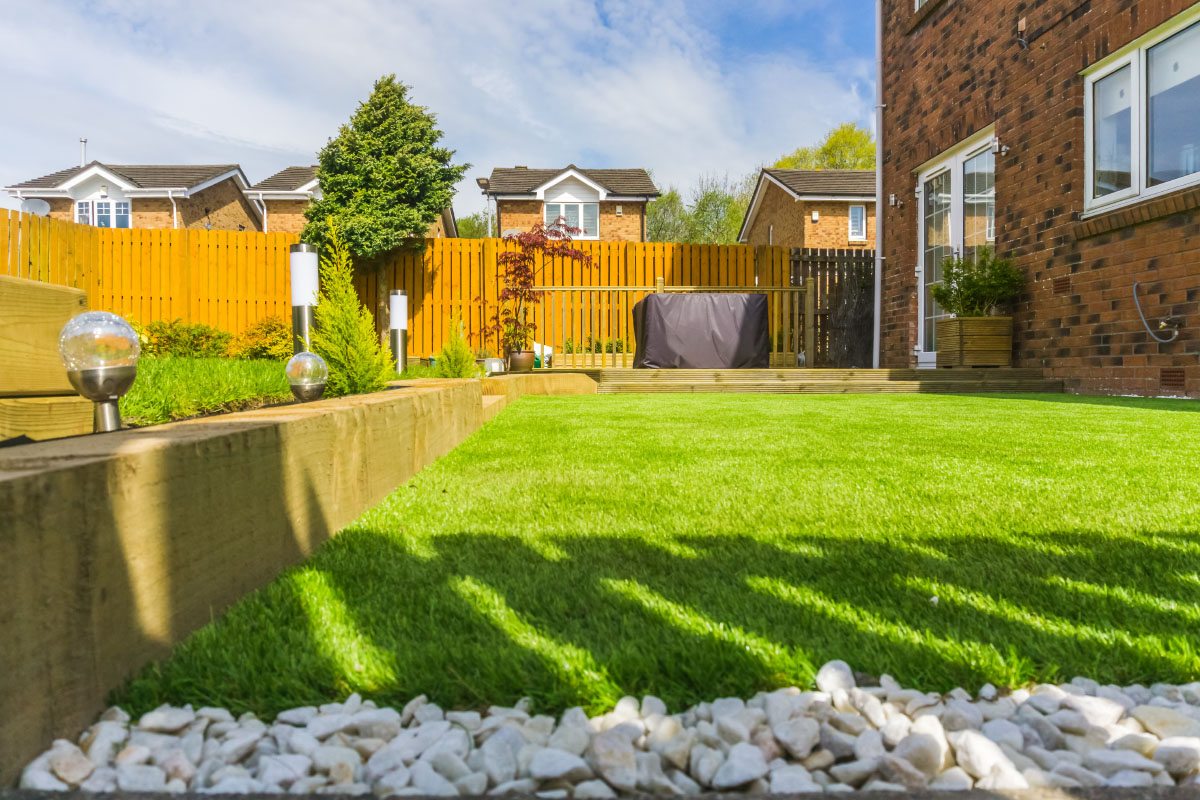
To prevent moisture from remaining in contact with the wood sleepers for long periods, a damp proof membrane (DPM) liner can be installed before you backfill with soil. If your flowerbeds are deep enough you could also backfill with aggregate to aid drainage further, but be aware that alkaline material such as limestone could affect plant growth.
2. Raised beds and planters
Wooden sleepers are a great alternative to working with expensive stone or brick, and installation requires less skill than many other materials.
A double or triple-layer construction can provide a convenient raised platform to maintain flowerbeds, will assist with drainage and also allows you to introduce some height to your garden design.
Multi-tiered or stepped flowerbeds are relatively easy to construct using sleepers and are ideal for gardens that slope. They can be used alongside steps, which you may also wish to build with railway sleepers to maintain a consistent aesthetic.
However, we’d strongly recommend you avoid using reclaimed sleepers treated with creosote, or where you’re unsure what chemicals have been applied to the wood. Creosote is a carcinogenic substance that can harm plants and should never be used to build raised beds for growing vegetables or edible flowers.
3. Garden steps
Railway sleepers offer a softer, more organic alternative to concrete or stone steps.
Depending on the size of each step, you could even fill the space between sleepers with a decorative aggregate that compliments the colour of your wood and provides additional traction. If your steps are constructed solely of wood, be mindful that you’ll need to keep them clean of algae to maintain a safe walking surface.
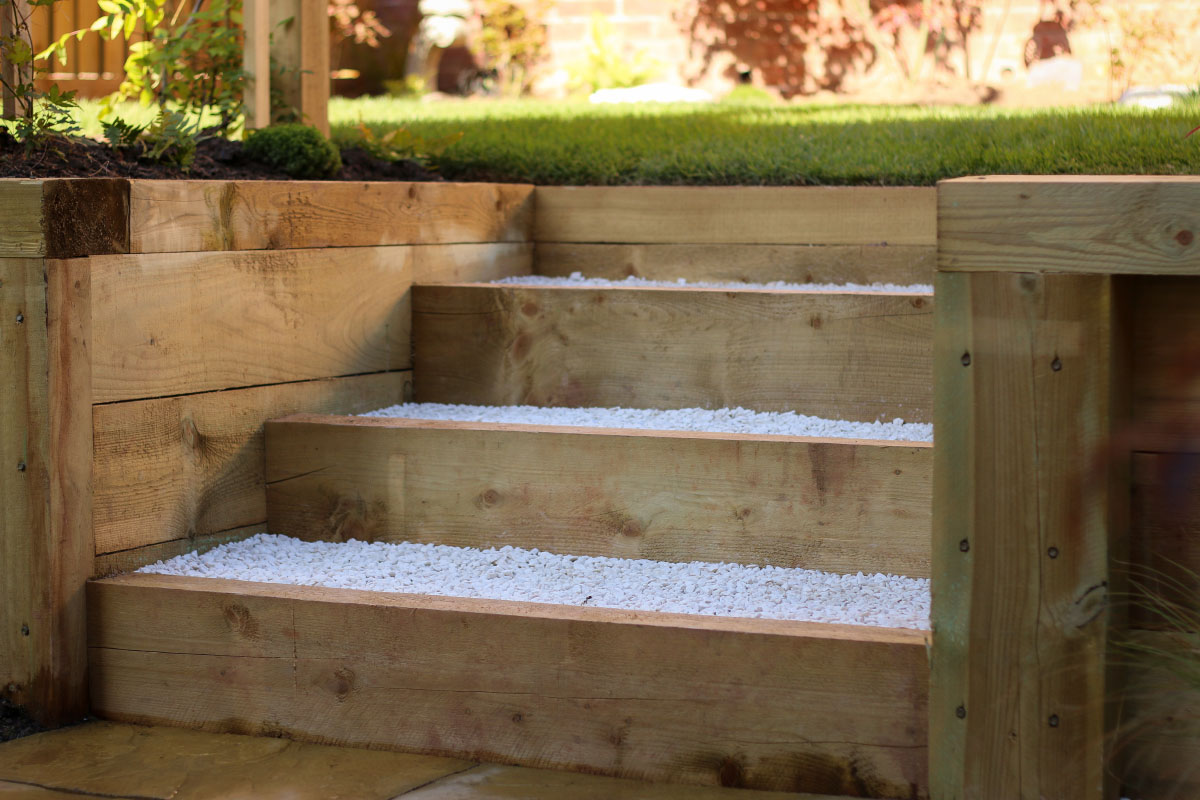
Steps need to be robustly constructed to ensure they can handle foot traffic, so we’d recommend preparing the ground accordingly and perhaps even using concrete footings in high traffic areas.
Sleepers can be fixed in place using a combination of picket stakes, fixing plates and steel rods. Angle brackets are also useful when securing sleepers that form 90 degree joints.
How far you go when engineering your steps will be dependent on their height and the number of steps involved, as well as the amount of traffic they’re likely to receive.
4. Garden paths
Garden footpaths constructed only of sleepers don’t always make for the most suitable walking surface, as they’ll require regular cleaning to prevent the path from becoming slippery.
That said, railway sleepers can make for an eye-catching addition to a decorative aggregate or stone tile walking surface, softening the hard landscaping in your garden. Either reclaimed or new garden sleepers can work well in this context and won’t need the same level of maintenance compared to a wood footpath, as the aggregate or stone tiles should provide ample traction.
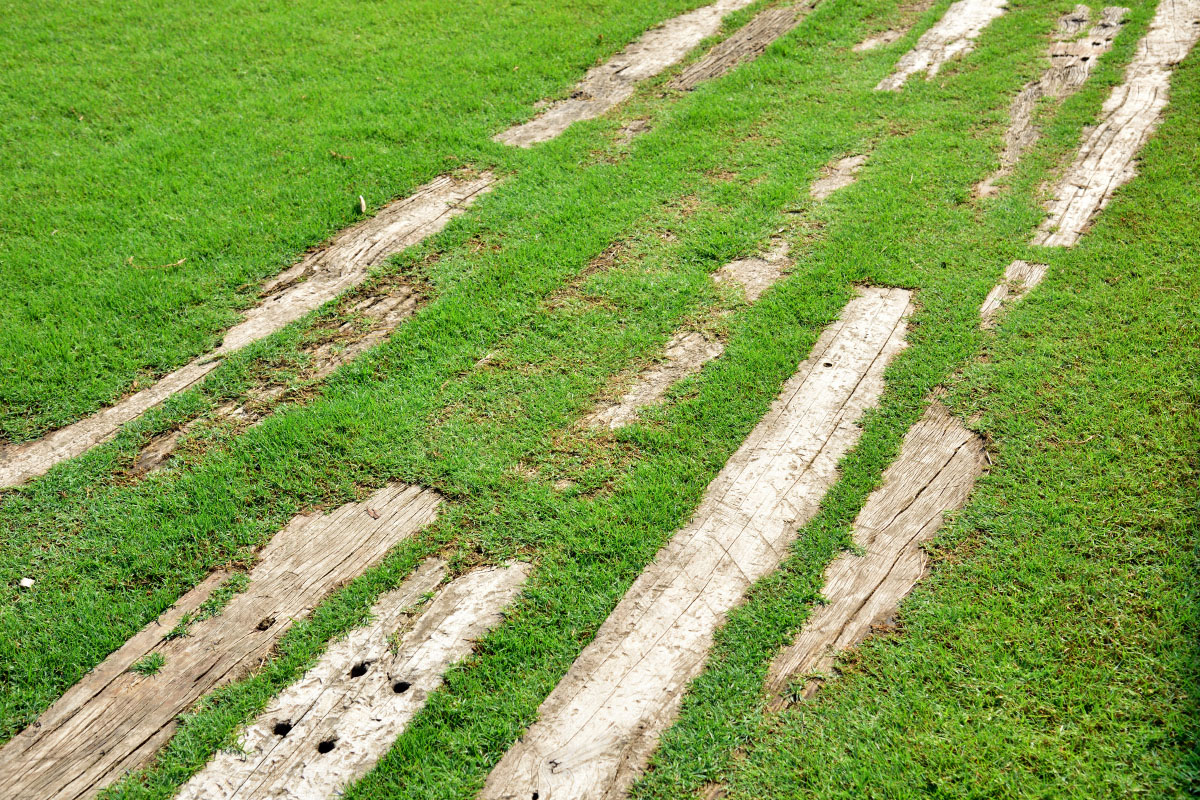
Prepare the ground according to the traffic that the path is likely to receive, and ensure the sleepers will protrude from the finished surface by approximately 25mm, to account for ground settling.
Sleepers can be placed on a relatively thin layer of sand when constructing a path in a low traffic area of your garden, but we’d recommend an aggregate sub-base for higher traffic areas and to encourage drainage.
As a large proportion of each sleeper will be in contact with the ground, treating the wood thoroughly with wood preserver will extend its lifespan. Pay particular attention to the freshly cut ends.
5. Retaining walls
Stone or brick-built retaining walls are expensive to construct and the softer, more organic aesthetic provided by railway sleepers may suit your garden better.
Sleepers can be used in vertical orientation, buried 600-900mm deep, or laid horizontally in conjunction with RSJs, steel I-beams or bolted to sleepers fixed in an upright position.
Use of a DPM liner is recommended and we’d also advise that you backfill with aggregate, to allow water to drain away freely.
Do bear in mind that anything taller than 1.2m above ground level should be designed by a structural engineer and take into account local ground conditions. Sleepers are a good choice up to c. 1.75m, but beyond that we’d recommend concrete and/or masonry. You could always clad a blockwork retaining wall in wood if you’re keen on the more organic look that this natural material provides.
6. Decking
Chunky garden sleepers can make for impressive decking but there are a number of challenges to consider, for example:
- Lack of grooved surface can make sleepers slippery underfoot.
- Sleepers will be expensive if used to construct large decking areas.
- Irregular finish of reclaimed railway sleepers could make for an uneven surface.
- Weight of individual sleepers can make construction difficult.
If you’re decking a larger area we’d recommend using sleepers sparingly, to build up the decking platform and to finish the edges. They can also be used to build walls around the decked areas, and as heavy-duty balustrades.
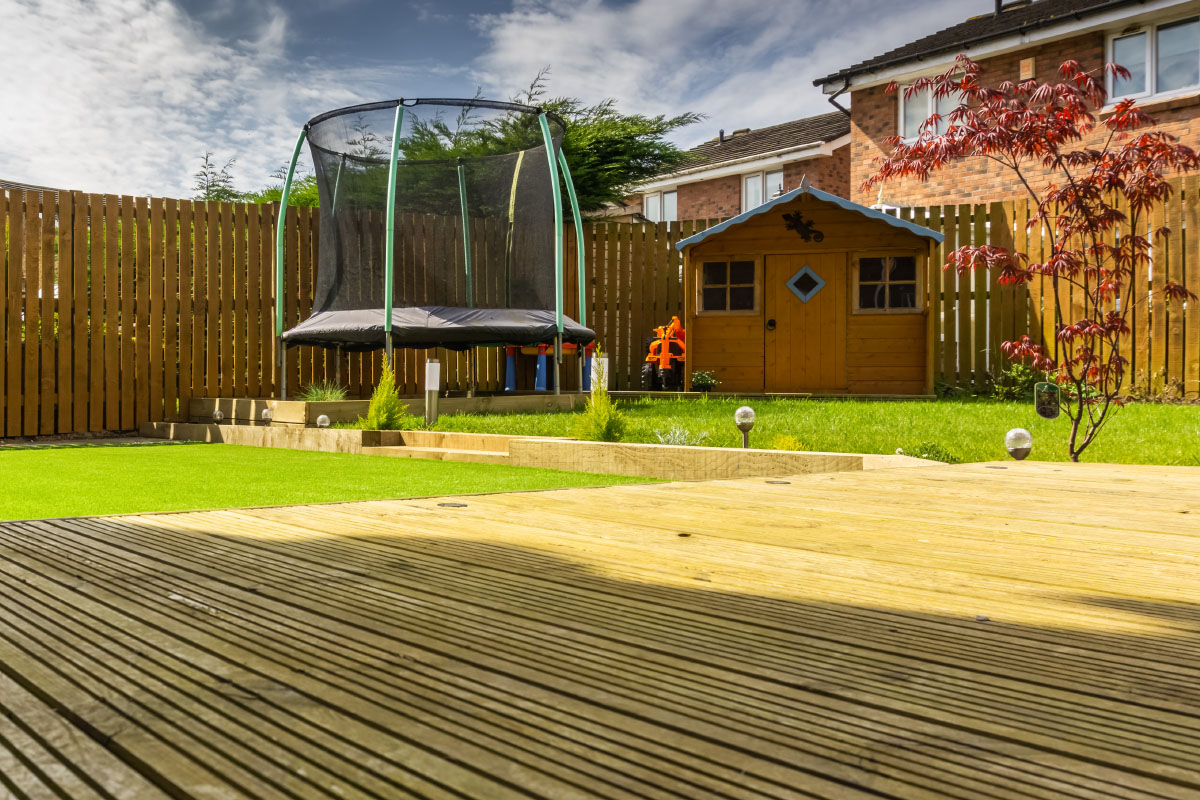
If you do intend to use wooden sleepers as the decking surface, it’s worth taking into account the regular maintenance that will be required to prevent the wood from becoming slippery.
Purpose-designed decking boards tend to have a grooved surface to provide traction. You could add similar grooves to sleepers but this would be quite time consuming.
Another solution is to paint the surface with anti-slip stain or paint that’s specifically designed for decking, but that will alter the clean aesthetic you paid extra for when settling on sleepers instead of decking boards.
Reclaimed sleepers may not make for a suitable walking surface as they tend to be irregularly shaped, with waney edges that could pose a trip hazard depending on how rough they are.
Hardwood sleepers in particular are extremely heavy (up to 50kg each), so if you have a large surface area to cover and you’re planning to complete the project yourself, it could be backbreaking work. 2.4m softwood sleepers weigh up to 30kg so they’re a more manageable option, but are nonetheless much heavier than decking boards.
One creative way to use sleepers in the garden is to cut them into blocks or setts, and lay them as you would block paving. Lower grade reclaimed sleepers could be used in this way as the cut ends should provide a level walking surface.
7. Garden furniture
Wooden sleepers are robust and relatively easy to work with, so it’s no surprise that advanced DIYers often use this material to build outdoor furniture.
Thanks to the heavy-duty nature of sleepers, using them to build furniture can make for attention grabbing statement pieces.
Benches, tables, seating areas and water features can all be fashioned using sleepers, and if pre-treated with a suitable wood preservative should last many years, even when continually exposed to the elements. However, you may wish to cover your wood furniture during harsh weather conditions to extend its life even further.
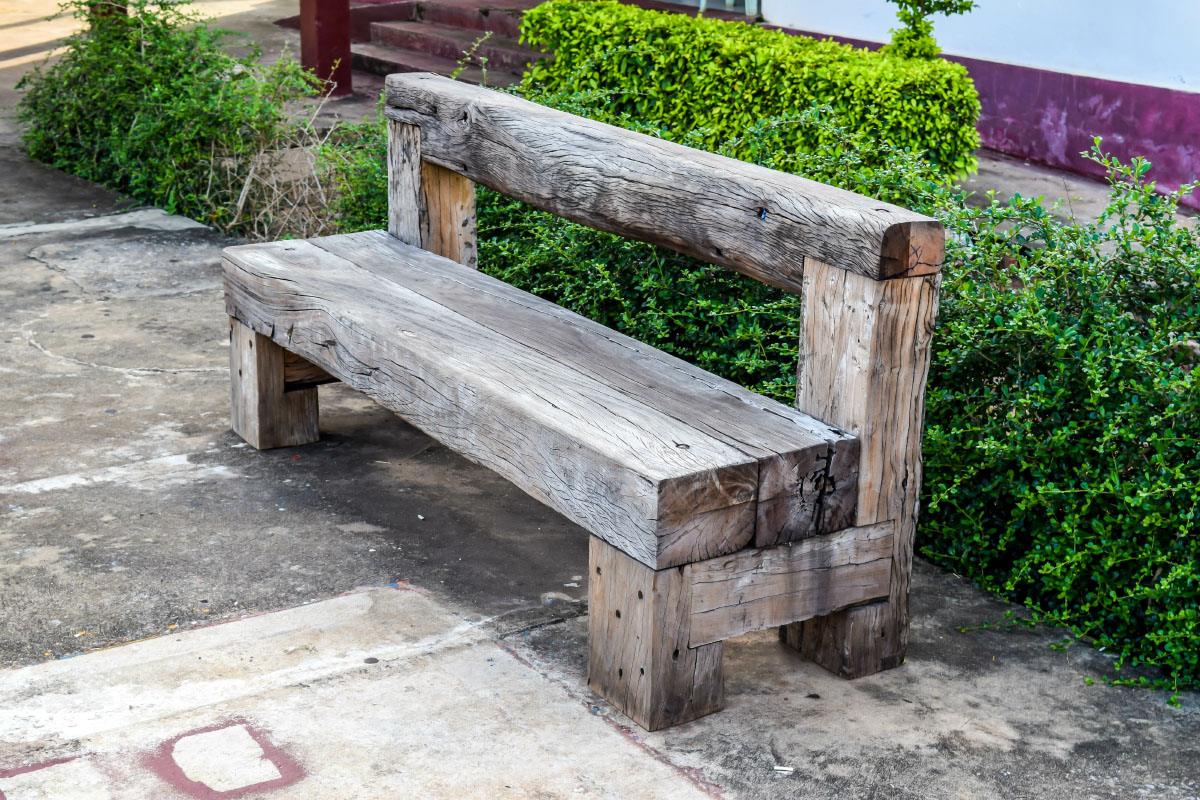
The chunky construction typical of furniture made with sleepers may also work in some interior contexts – for example, dining or coffee tables – but you’ll want to prioritise the quality of the finish if you’re planning to use sleepers indoors.
Reclaimed sleepers can be used to build furniture but this is another scenario where it’s important not to use sleepers impregnated with creosote or other harmful chemicals, as these substances should not come into contact with human skin.
Creosote impregnated sleepers are not appropriate for indoor use in any context.
8. Garden ponds
Garden sleepers used to frame and support raised ponds or other water features can add a unique, rustic touch to the centrepiece of your outdoor space. Ponds in particular will help aquatic life flourish, from plants through to frogs and other amphibians such as newts.
Sleepers can be placed vertically or horizontally depending on the design you prefer. Vertical sleepers are ideal for curved designs, which typically can’t be achieved when placing sleepers horizontally.
Care must be taken to ensure that the sleepers aren’t in constant contact with water, as wood will rot, decay and split if it remains wet for extended periods. Heavy duty geotextile fabric can be used in advance of the pond liner being installed to reduce the chance of puncture and provide additional protection to the liner.
Sleepers can be used to frame other types of water feature, including those with running water, but the design should accommodate drainage to ensure that water flows away before coming into direct contact with the wood.
Running water combined with the aesthetic beauty of wood will contribute a zen-like ambience to your garden and help you create a tranquil oasis, even in the heart of the city.
Which railway sleepers should I use
Sleepers are available in a wide range of materials, from untreated softwood through to tropical hardwood, and can range from around 0.8m to as long as 4m.
The most common size of new garden sleeper available in the UK is 2.4m (2400mm) long, 200m high and 100mm wide.
Reclaimed hardwood sleepers are typically 2.6m long and are available in different grades, with grade 1 or A being the tidiest, while grades 3 or C are likely to be quite irregular, with waney edges and perhaps even splits in the wood.
The material, grade and size you settle on should be determined by a range of factors, including budget, the size of the space you’re landscaping, the aesthetic you wish to achieve and your expectations around longevity.
New softwood sleepers
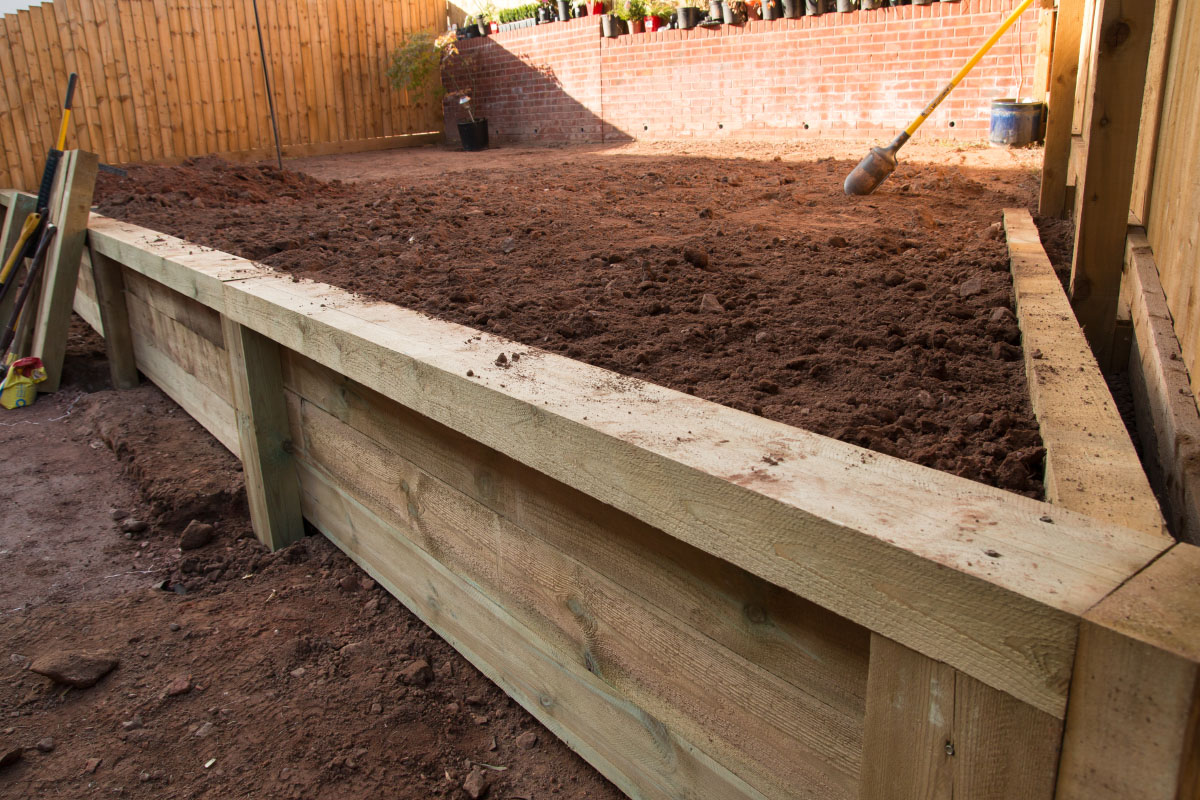
New hardwood sleepers
New hardwood sleepers are similar in appearance to those manufactured from softwood but last longer, up to 100 years depending on how they’re installed and where they’re positioned.
Oak sleepers are commonly available in the UK but it’s also possible to source sleepers manufactured from African azobé (ekki), tali and other tropical hardwoods, such as eucalyptus.
Tropical hardwood sleepers are the longest lasting sleepers available on the market but tend to be very expensive, and there’s also the environmental impact to consider. While the wood itself may be PEFC/FSC certified and sourced from sustainable forests, the carbon footprint associated with transportation from the African continent or Australasia could be considerable.
Reclaimed railway sleepers
If you’d prefer a more rustic finish, reclaimed sleepers may be the way to go.
The reclaimed sleepers available in the UK are usually creosote-treated pine or oak sleepers, but it’s also possible to source reclaimed, untreated azobé sleepers.
When buying reclaimed sleepers you should expect some variance in terms of size and condition, with the higher grade sleepers the more expensive option.
If you’re using sleepers to create a walking surface we’d recommend either the highest grade reclaimed sleeper you can find, or new sleepers, as irregular shapes and rough edges could pose a trip hazard.
As previously mentioned, wood treated with creosote is unsuited to many uses due to the carcinogenic character of this preservative. Hence you should be selective when using reclaimed sleepers to build raised flowerbeds or planters – particularly those where edible plants are to be grown – and care should be taken to ensure creosote never comes into contact with skin.
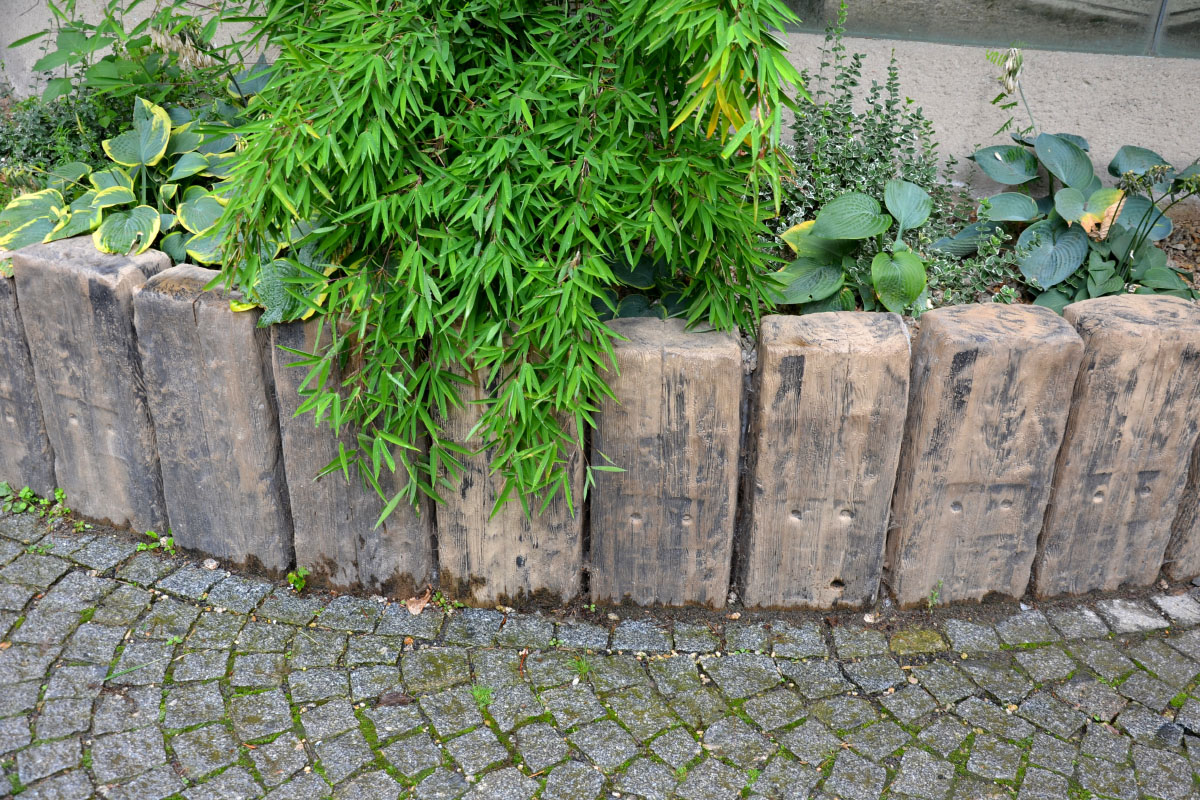
It’s not recommended to install creosote treated sleepers in high traffic areas and they should never be used near childrens’ play areas or as furniture, whether indoors or outdoors.
New treated sleepers should be safe as treatments such as Creosolve, Creocote, Tanasote and Tanalith E have passed all relevant environmental, human and animal health risk assessments.
Garden sleepers vs. railway sleepers
When researching which sleepers to use for your project you may have come across various different names used to refer to sleepers, including “garden sleepers”, “railway sleepers”, “wooden sleepers” etc.
There’s no need for confusion as these terms refer to the same product, although reclaimed sleepers are most often sold as “railway sleepers”, with new sleepers usually referred to as “garden sleepers”.
The term “railway sleepers” or “sleepers” more generally is a callback to their original function: support for the rails in railway or railroad tracks. Also called “ties”, sleepers have been used in this way for over 150 years, but in many places are being replaced with concrete, steel or composite ties.
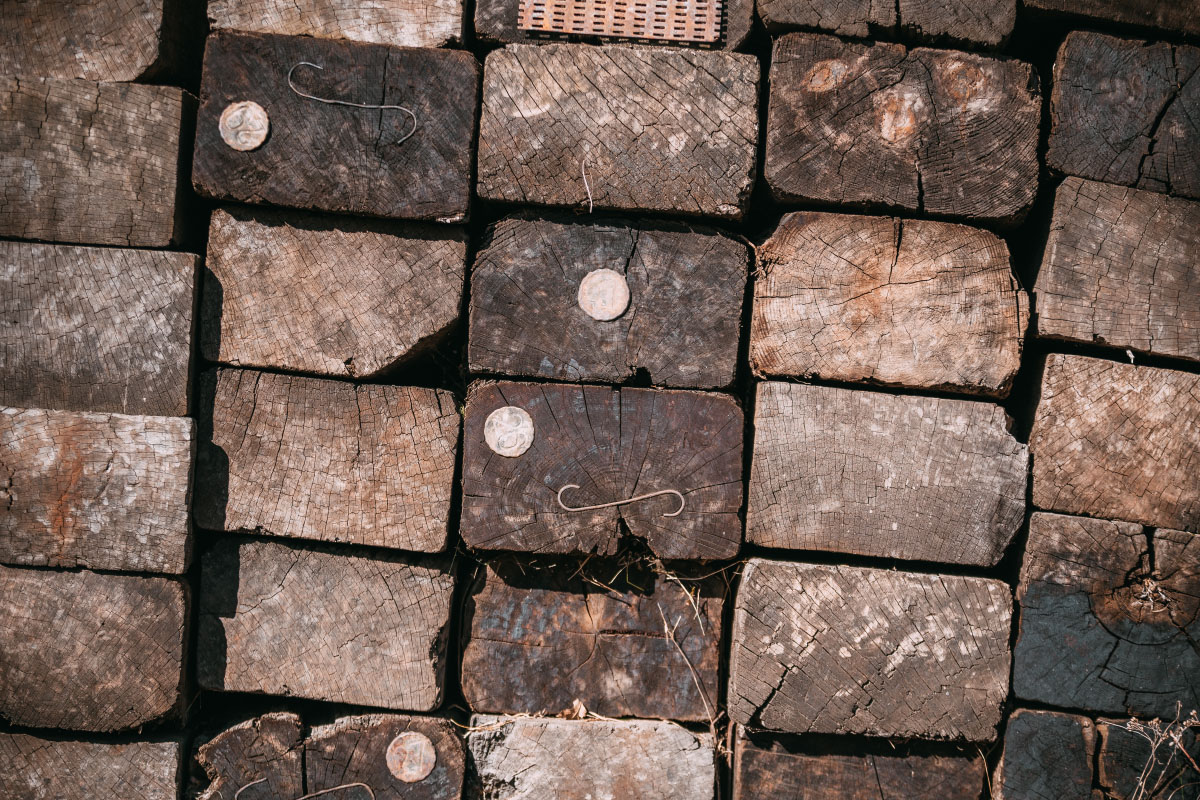
What's the best way to cut railway sleepers?
Timber sleepers can be large and heavy, but cutting them doesn’t need to be a chore: you just need to make sure you have the right tools for the job.
Softwood and even dry oak sleepers can be cut using a sharp handsaw, but this process will soon become laborious if you have more than just a few cuts to make.
A circular or mitre/chop saw with a large diameter blade (c. 270-305mm) that allows you to make a single cut through the full depth of the timber is the easiest option. However, large diameter saws can be quite expensive.
If you only have access to a saw with a smaller diameter blade, it’s possible to make a cut from one side and then flip the sleeper over, cutting again from the opposite surface. If you line up your cuts carefully, the cut ends should be tidy enough for most applications.
There are other options, including chainsaws, alligator saws and reciprocating saws, but these tools require more skill to achieve accurate cuts and can be quite dangerous if handled improperly.
While modern circular saws can be safer than some other options, any power tool can cause serious injury if misused. If you have any doubt about your competence, call on someone who’s familiar with such tools. Manoeuvring, cutting and installing railway sleepers is typically a two-man job in any case.
Maintaining railway sleepers
Cleaning and maintenance
While sleepers used as garden edging or to construct a retaining wall don’t require cleaning, any wood that’s intended to be walked upon can become slippery if not maintained properly.
Here are a few things you can do to keep wooden paths, steps and decking safe:
- Regular sweeping to remove dirt, moss and algae.
- Occasional low pressure power wash to remove any embedded dirt or algae.
- Preventing standing water from forming by ensuring water can drain away freely.
- Use a deck or wood cleaner that contains mould and algae inhibitors.
- Check for wood rot or infestations that might cause damage.
You could also apply anti-slip decking strips or stain, but both these options are likely to dramatically alter the aesthetic of the wood and compromise the design of your outdoor space.
Extending the life of your garden sleepers
Softwood
New sleepers manufactured from pine or other softwoods must be pre-treated prior to installation to ensure longevity.
Suitable treatments include tanalisation using Tanalith E or a similar product, or preparation with a creosote alternative such as Creosolve.
Reclaimed softwood sleepers are likely to have been treated with creosote, which will ensure longevity, but as discussed previously there are health considerations to think about before installing creosote impregnated timber.
Hardwood
There are a variety of hardwood sleepers available on the market, both new and reclaimed, with many not requiring treatment prior to installation due to the density of the wood.
That said, the occasional application of linseed or Danish oil will ensure your hardwood sleepers always look their best.
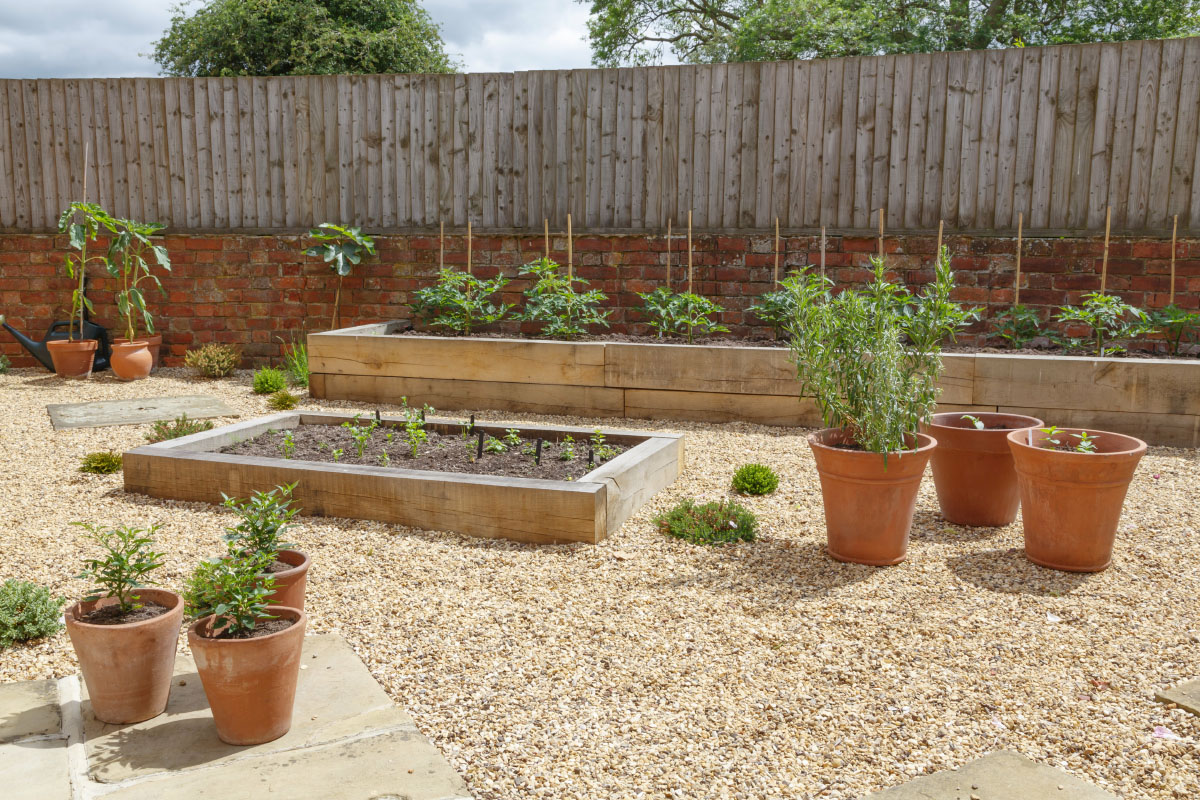
It’s important to avoid scenarios where wood remains in contact with water for extended periods, so use of a DPM liner and aggregate backfill is advised where sleepers will be buried or partially buried in the ground. Where this isn’t practical, we’d recommend you double-up on treatment to prevent your sleepers from rotting prematurely.
You may also wish to occasionally apply treatment to areas where plants grow over a sleeper’s surface, as this growth will prevent the sun from drying out the wood and could increase the rate of decay even in hardwood sleepers. Make sure to use a preservative that’s safe to use around plants.
Frequently asked questions
The lifespan of garden sleepers depends on a few variables, including:
- Material: whether the sleepers are hardwood or softwood.
- Preservative: the type and level of preservative applied to sleepers.
- Age: reclaimed sleepers could already be decades old when you install them.
- Liner and drainage: whether a damp proof membrane and aggregate backfill has been used to protect buried or partially buried sleepers.
- Climate: sleepers exposed to harsh, wet conditions won’t last as long as those positioned in sheltered spots in enclosed gardens.
For example, oak or azobé sleepers placed above ground in a sheltered spot could last in excess of 100 years.
UC3 treated softwood sleepers buried without the use of a DPM liner and regularly exposed to moisture may last less than 10 years.
If your projects involves sleepers being buried, partially buried or any other scenario where they’re likely to be in constant contact with moisture, then a damp proof membrane (DPM) between the wood and source of moisture is advised.
Additionally, sleepers should be positioned on a sub-base that encourages water to drain away, and aggregate backfill can be used alongside a DPM as a means to improve drainage even further.
Sleepers used for simple, single height raised beds can be placed directly onto soil, provided the soil constitutes a stable, compacted surface.
Larger or more elaborate constructions should be placed on a prepared sub-base with sufficient drainage, while heavy retaining walls may benefit from concrete footings.
Creosote is a potentially harmful carcinogenic substance commonly used to preserve timber railway ties, and sleepers treated with creosote shouldn’t be used where edible plants are to be grown or where people may come into contact with the wood.
One tell-tale sign that sleepers have been treated using creosote is that the surface of the wood appears dark and may even seem to be covered in a tar-like substance.
The sleepers may also smell unpleasant, particularly in hot weather or when exposed to direct sunlight.
If you have any doubt about the presence of creosote our advice would be to not use the sleepers and instead source material that’s been treated using methods that don’t pose any risk to health.
Bolts, screws, angle brackets, connector plates, posts, stakes, steel I-beams, RSJs, wooden dowels, metal rods and concrete can all be used to secure sleepers in position and connect them to other sleepers.
How you approach this should be determined by how ambitious your project is, with heavier or more complex constructions necessitating the most robust methods.
Sleepers can range from around 30kg to 80kg, depending on their size and the material they’re manufactured from.
We would advise that you have someone help you manoeuvre your sleepers, particularly hardwood sleepers as they can be very difficult to handle alone.
UC3/4 pressure treated softwood sleepers should not require re-treating following installation, except where plants grow over the sleepers and retain moisture. In this scenario we’d recommend you apply a plant-safe wood preservative every few years in these areas, as an insurance policy to prevent the wood from deteriorating.
Sleeper chic: begin transforming your garden today
You now have all the knowledge you need to get started transforming your garden with timber sleepers.
Remember – when choosing materials, think carefully about how you intend to use the sleepers as this should inform your decision. Sleepers can be a cost-effective and long-lasting way to elevate your outdoor space, with options available to suit all budgets and garden designs.
Good luck!

